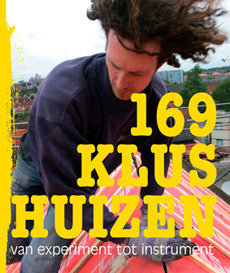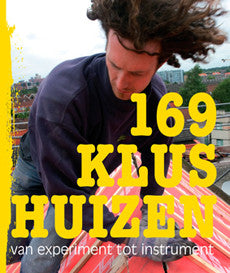Your cart is currently empty!
Architecture
169 KLUSHUIZEN
+++Van experiment naar instrument+++
+++Annemarie Sour [text], Joop Reijngoud [photography]+++
978-90-5973-116-5 [episode]
Ping-Pong Design | Meike Nip
452
22 x 19,5 cm
Paperback
Only available in Dutch
This publication has been made possible by the Municipality of the City of Rotterdam
special offer: now only € 12.50 (incl. 9% VAT) instead of € 25,00
Rotterdam's position at the beginning of the twenty first century is not at its best. Parts of its urban areas are dilapidated. Poorly maintained buildings and sites due for demolition make their desolate appearance even worse. This is where crime occurs and rack-renters do good business. Illegal occupation has become widespread and there are inhabitants who feel unsafe. Those who have money and look for peace and quiet are leaving. The current approach, which involves major repairs or neighbourhood restructuring, has proven inadequate.
How to attract buyers to a run-down neighbourhood? How to change the neighbourhood's negative image and transform it into a trendy hot spot within a couple of years? A bold experiment has enabled the City of Rotterdam to achieve a breakthrough in such areas. The new municipal executive that took office in 2002 intends to deal with the issue in a different way.
The nine most dilapidated neighbourhoods, the so-called 'hot spots', get an extra impetus. These neighbourhoods are characterized by an unbalanced ratio of owner-occupied to rented homes. Ratios of 95 per cent rented to 5 per cent owner-occupied are no exception, both in Rotterdam North and Rotterdam South.
An important element in the improvement of the residential environment is the refurbishment of the existing housing stock. Though the dwellings are too good to be pulled down, they are in a very poor state of repair. Through investment in the refurbishment of only façades and roofs in other projects, building blocks were given a monumental appearance. Unfortunately, in spite of the pretty façades, nothing has changed behind the front doors. The municipality purchases a large number of run-down buildings that are located in the hot spot areas.
The dwellings are sold at a bargain price to – primarily – enthusiastic young people. It is up to them to convert their acquisition into a top-class dwelling: a dream house. The future residents are assisted with putting ideas into practice by architects, special civil servants responsible for issuing permits and other expert advisors. This can be done on an individual basis or collectively. As far as the City of Rotterdam is concerned, this approach has not only resulted in improved dwellings, their sustainable maintenance and more differentiation in the existing housing stock, but foremost in attracting a new group of young creative residents to these deprived areas.
The publication 169 Klushuizen. Van Experiment tot instrument (169 Klushuizen (DIY homes): from experiment to instrument) presents the results of this new approach.
Van experiment naar instrument
€12.50
169 KLUSHUIZEN
Van experiment naar instrument
€12.50
Architecture / Special offer / Theory / Urbanism
978-90-5973-116-5 [episode]
Ping-Pong Design | Meike Nip
452
22 x 19,5 cm
Paperback
Only available in Dutch
This publication has been made possible by the Municipality of the City of Rotterdam
special offer: now only € 12.50 (incl. 9% VAT) instead of € 25,00
Rotterdam's position at the beginning of the twenty first century is not at its best. Parts of its urban areas are dilapidated. Poorly maintained buildings and sites due for demolition make their desolate appearance even worse. This is where crime occurs and rack-renters do good business. Illegal occupation has become widespread and there are inhabitants who feel unsafe. Those who have money and look for peace and quiet are leaving. The current approach, which involves major repairs or neighbourhood restructuring, has proven inadequate.
How to attract buyers to a run-down neighbourhood? How to change the neighbourhood's negative image and transform it into a trendy hot spot within a couple of years? A bold experiment has enabled the City of Rotterdam to achieve a breakthrough in such areas. The new municipal executive that took office in 2002 intends to deal with the issue in a different way.
The nine most dilapidated neighbourhoods, the so-called 'hot spots', get an extra impetus. These neighbourhoods are characterized by an unbalanced ratio of owner-occupied to rented homes. Ratios of 95 per cent rented to 5 per cent owner-occupied are no exception, both in Rotterdam North and Rotterdam South.
An important element in the improvement of the residential environment is the refurbishment of the existing housing stock. Though the dwellings are too good to be pulled down, they are in a very poor state of repair. Through investment in the refurbishment of only façades and roofs in other projects, building blocks were given a monumental appearance. Unfortunately, in spite of the pretty façades, nothing has changed behind the front doors. The municipality purchases a large number of run-down buildings that are located in the hot spot areas.
The dwellings are sold at a bargain price to – primarily – enthusiastic young people. It is up to them to convert their acquisition into a top-class dwelling: a dream house. The future residents are assisted with putting ideas into practice by architects, special civil servants responsible for issuing permits and other expert advisors. This can be done on an individual basis or collectively. As far as the City of Rotterdam is concerned, this approach has not only resulted in improved dwellings, their sustainable maintenance and more differentiation in the existing housing stock, but foremost in attracting a new group of young creative residents to these deprived areas.
The publication 169 Klushuizen. Van Experiment tot instrument (169 Klushuizen (DIY homes): from experiment to instrument) presents the results of this new approach.



